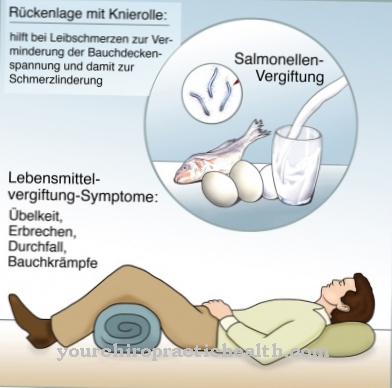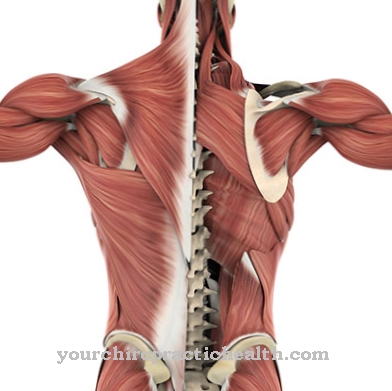Under the Wolf-Hirschhorn Syndrome the doctor understands a complex of symptoms from various malformations. The syndrome occurs as a result of a structural abnormality of chromosome four, which usually corresponds to a new mutation. The disease is incurable and can therefore only be treated symptomatically.
What is Wolf-Hirschhorn Syndrome?
The Wolf-Hirschhorn Syndrome or Wolf Syndrome is a genetically determined complex of symptoms consisting of malformations. The clinical picture corresponds to a structural chromosome aberration, i.e. a structural anomaly of the chromosome set. The main symptom of the syndrome is short stature. The physical and mental development of the affected children is severely delayed and is accompanied by various malformations. The prevalence of the disease is estimated to be one in 50,000.
In Germany there are a little over ten newly diagnosed cases per year. Girls are slightly more likely to be affected by the complex of symptoms than boys. Ulrich Wolf and Kurt Hirschhorn first described the disease independently of one another in the 20th century. As of 1998, US researchers speak of only 120 documented cases. As a result, many cases of Wolf Syndrome would go undetected until the 21st century.
causes
Wolf-Hirschhorn syndrome is caused by a chromosomal abnormality on the short p arm of chromosome four. Those affected lack sections of different sizes in this area. A deletion of around 165 kilobase pairs in band 4p 16.3 is the smallest anomaly that can cause the symptoms of Wolf syndrome. In around 90 percent of the cases, the mutation of chromosome four occurs completely new. This means that the Wolf-Hirschhorn syndrome is usually not inherited, but arises in the paternal chromosome.
In ten percent of the cases, a balanced translocation from the chromosomes of a parent causes the malformation complex. A section of chromosome four is shifted to another chromosome. If such a repositioning of chromosome segments caused the disease, there is a probability of around 50 percent that a second child of the parents will also develop Wolf-Hirschhorn syndrome.
Symptoms, ailments & signs
Facial malformations occur in all patients with Wolf syndrome. These include in particular enlarged eye sections with sloping eyelid axes and a wide nose or a small jaw. A high forehead or a long skull are just as common. The same applies to protruding or widely spaced eyes, upper lip furrows, cleft palate and jaw, drawn down corners of the mouth and scalp defects or a chin that is turned back.
Often those affected have a short neck and deep-set ears, some of which are deaf. The eyes are often trembling or have glaucoma or cataracts from birth. Iris crevices, squinting or curvature of the cornea also occur. In connection with the brain, there is often a constriction of the brain due to premature hardening of all cranial sutures, an underdevelopment of the cerebellum or an epileptic disposition.
In addition to malformations of the kidneys, there are also malformations of the heart with cardiac arrhythmias or heart valve defects. Sometimes the genitals and extremities are also malformed, for example in the form of a doubled thumb.
Diagnosis & course of disease
A low birth weight, combined with susceptibility to infection, small size and developmental disorders, can give a doctor the first signs of the disease. The definitive diagnosis can rarely or only uncertainly be made through examinations. The doctor is therefore more likely to use fluorescence in situ hybridization to confirm the first suspicion.
This is a cytogenetic procedure that detects numerical and structural chromosomal abnormalities. Fluorescence-marked DNA probes are used as markers. The prognosis is poor for patients with Wolf-Hirschhorn syndrome. Around a third of all those affected die in their first year of life. The prognosis for girls is slightly better than for male patients. For example, about two thirds of the patients who survive the first year of life are female.
Complications
Due to the Wolf-Hirschhorn Syndrome, those affected suffer from a number of malformations and deformities that have a very negative effect on the quality of life and on the everyday life of the person concerned. As a rule, the nose is very wide and the jaw is relatively small.
The consumption of food and liquids can also be made significantly more difficult due to the Wolf-Hirschhorn Syndrome. Therefore, especially with children, there is also bullying or teasing, so that the patients often suffer from psychological complaints or from depression. Parents and relatives are also often affected by these complaints.
The syndrome also leads to persistent squint and possibly other visual problems. There are also disorders of the heart or even a heart valve defect, which can be fatal for the person concerned. Some patients also have a duplicate thumb.
Wolf-Hirschhorn syndrome is usually treated purely symptomatically, so that the course of the disease is not completely positive. Whether the syndrome will lead to a reduction in life expectancy cannot generally be predicted.
When should you go to the doctor?
Usually, delivery takes place under the supervision and accompaniment of medical staff. Immediately after the birth, the members of the obstetrician team automatically and independently check the health of the newborn child. The first irregularities and abnormalities in health are documented. In acute cases, the first interventions are carried out at this stage. Further medical tests will then be carried out to clarify the symptoms.
Ultimately, a diagnosis of this disease takes place within the first days or weeks of life, as it is a matter of severe health problems. For this reason, parents or relatives of the child do not have to take action independently. Wolf-Hirschhorn syndrome already shows during birth due to optical irregularities that require action.
However, if the abnormalities go unnoticed, abnormalities in the state of health will appear within the first few weeks at the latest. Parents should consult a doctor with their child if they notice visual changes in the area of the face or if the position of the eyes does not correspond to the natural position. Disorders of the heart rhythm or deformation of the limbs are considered signs of an existing disease. A visit to the doctor is necessary as the newborn child needs early medical care.
Treatment & Therapy
So far, the Wolf-Hirschhorn syndrome is incurable. This means that no causal therapies are available. Treatment of the symptoms is possible. However, not all of them can be treated satisfactorily. In particular, a high-calorie diet is ordered at the beginning to compensate for the patient's underweight. Physiotherapy and occupational therapy are used to support motor development.
Some malformations in patients can be corrected surgically, for example doubled fingers or toes. The doctor usually gives medication for symptoms such as epilepsy.In this context, the administration of valproic acid or potassium bromide is most frequently indicated. The mental development of the patient is supported by therapeutic steps. Among other things, speech therapists can fulfill this purpose. The aim of symptomatic treatment is in particular to improve the quality of life.
The child, but also the parents, ideally receive intensive care as part of the therapy. If necessary, a psychotherapist is available to the parents. Although there are currently no causal therapies, Wolf-Hirschhorn syndrome may be curable in the future. Medical research is currently dealing, for example, with the exchange of defective genes, which may in future alleviate the malformation complex through the early exchange of chromosome four.
prevention
Like any other chromosome mutation, Wolf-Hirschhorn syndrome cannot be prevented. Parents who have already given birth to a child with the malformation complex can, however, have the probability of the disease assessed for future offspring and thus prevent a recurrence if necessary.
Aftercare
As a rule, those affected with Wolf-Hirschhorn syndrome have very few and only very limited measures available for direct follow-up care. Therefore, you should consult a doctor as early as possible with this disease and initiate treatment so that there are no complications or other complaints in the further course.
Therefore, early diagnosis and subsequent treatment of this disease is the main focus of this disease. Since Wolf-Hirschhorn syndrome is a hereditary disease, it usually cannot be completely cured. If you want to have children, genetic testing and counseling should always be carried out in order to prevent the disease from recurring in the descendants.
As a rule, those affected by Wolf-Hirschhorn Syndrome are dependent on the measures of physiotherapy and physiotherapy. This can alleviate some of the symptoms. Furthermore, the support from your own family in everyday life is very important.
Sometimes this can also prevent or limit depression and other psychological upsets. It is also often useful to have contact with other sufferers of the syndrome, as this leads to an exchange of information. The life expectancy of the person affected is usually not reduced by this disease.
You can do that yourself
The symptomatic treatment of Wolf-Hirschhorn syndrome can be supported by the sick person and their relatives with a number of general measures.
An adapted diet counteracts being underweight. Affected children need a high-energy diet, which may have to be supplemented with food supplements. The various physical malformations are treated through physiotherapy, speech therapy and occupational therapy. Physiotherapy, speaking and movement exercises can be performed at home. In the event of an epileptic seizure, the emergency services must be called. If available, the patient will be given an emergency medication such as valproic acid. Wolf-Hirschhorn syndrome requires long-term treatment, which is best planned together with the responsible pediatrician.
In addition to organizing doctor's appointments and surgical interventions, the child must be registered at a special kindergarten. The doctor provides the necessary contact points for this. Children who are already a little older can be informed about their illness. It is recommended to use age-appropriate reading. At best, the treating pediatrician is also present and can answer any open questions from the child. Close cooperation with the responsible doctors is also necessary during the treatment of Wolf-Hirschhorn Syndrome.



.jpg)
.jpg)

.jpg)

















.jpg)



